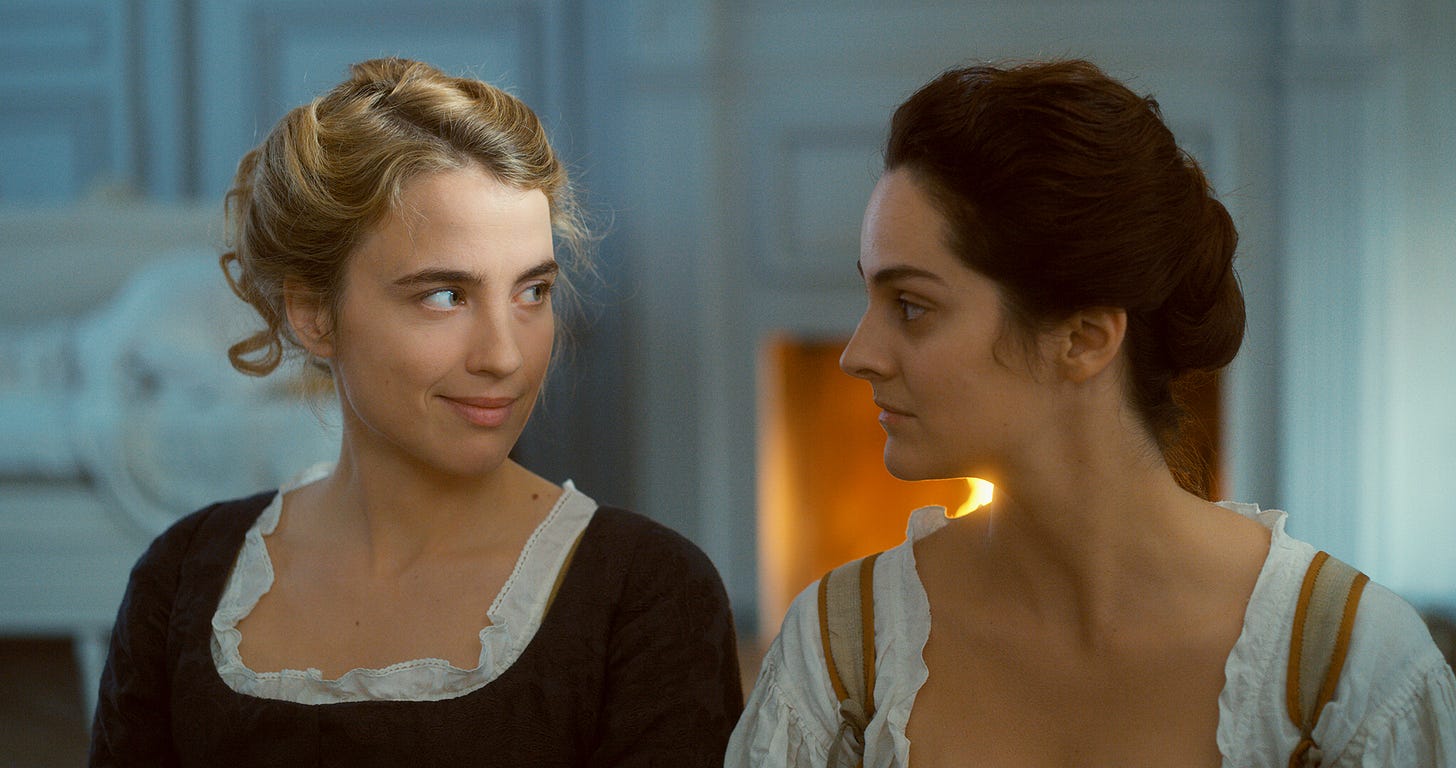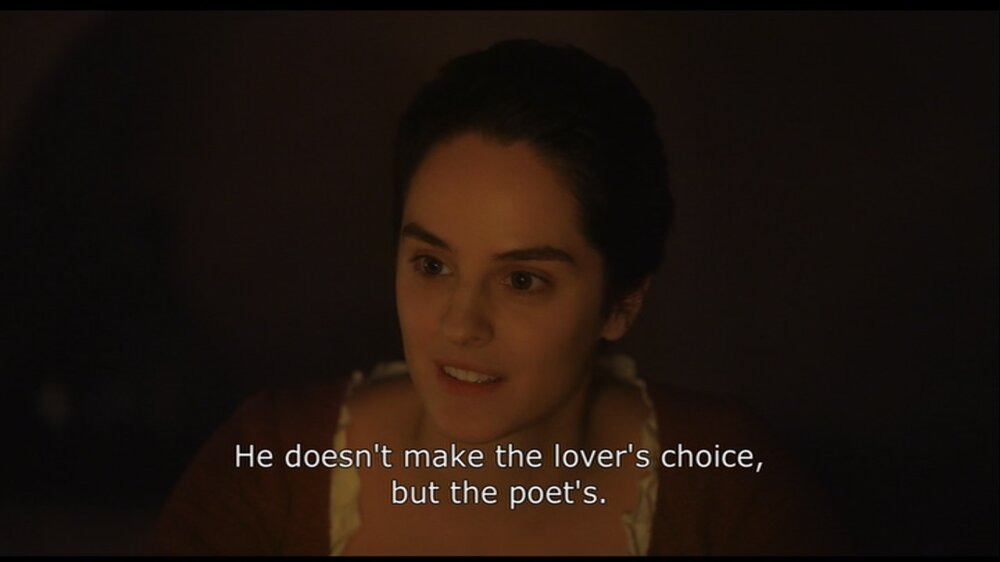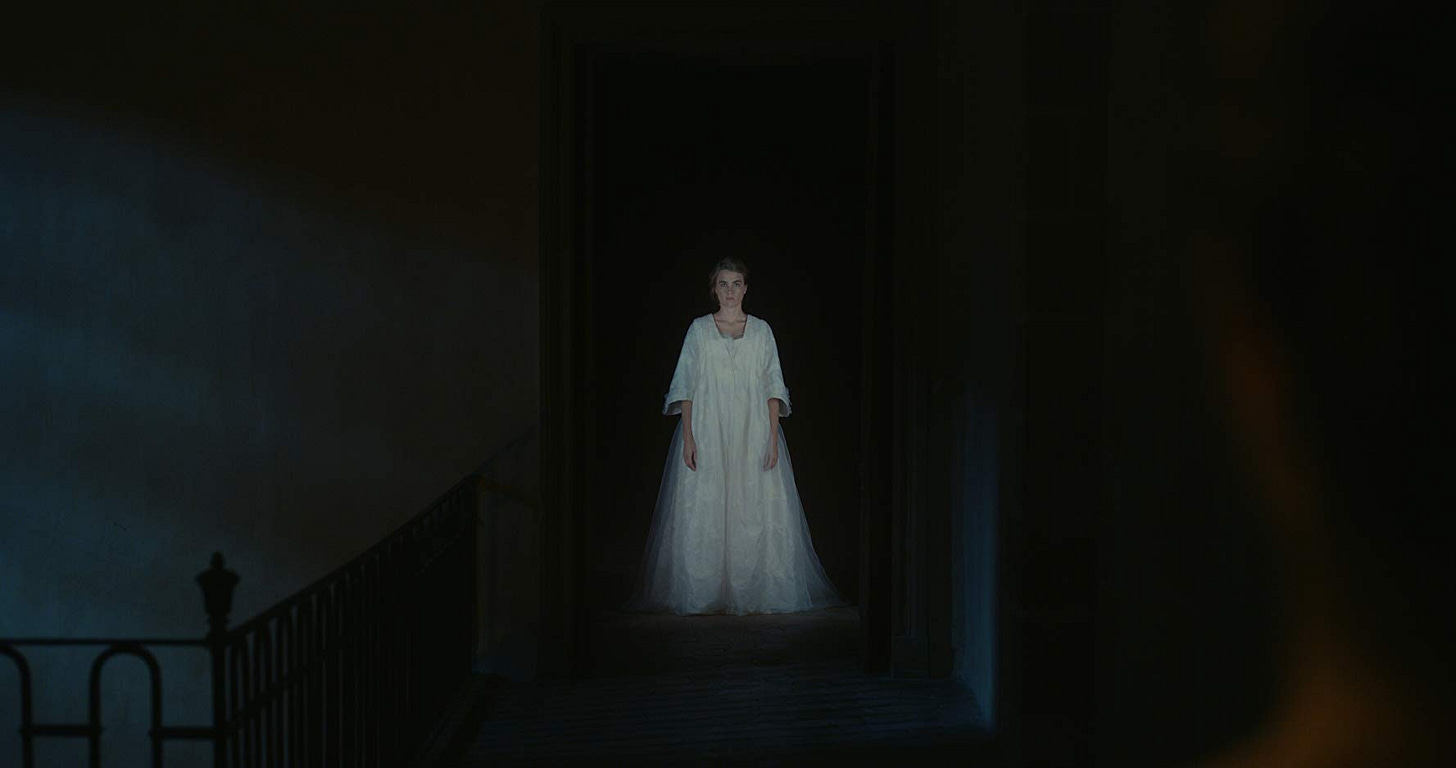Portrait of a Lady on Fire (2019)
In which the new live, love, laugh is Lesbians, Loss, and Lacan
In an interview with director Céline Sciamma, she stated that one of her aims in Portrait of a Lady on Fire was to portray and deconstruct the lesbian gaze. The idea of a lesbian gaze refers to the term 'male gaze', a concept first introduced by Laura Mulvey in the essay "Visual Pleasure and Narrative Cinema" (1975). The 'male gaze' refers to the masculine, heterosexual perspective typical to most cinema, which often presents women as objects for the aesthetic and sexual pleasure of men. In light of this, what does Sciamma mean by a lesbian gaze? How does she deconstruct it?

so! many! gazes! so much sexual tension!
In Portrait of a Lady on Fire, Marianne, an artist, is commissioned to paint the portrait of a young woman, Héloïse. However, Héloïse's mother explains this must be done in secret. The portrait is to be used to marry Héloïse to a wealthy suitor, a marriage that she refuses. After finishing an initial portrait, Marianne destroys it, dissatisfied with her work. As she works on a second portrait, she and Héloïse fall in love. The movie ends with Héloïse going along with her marriage, and Marianne recounting the last few times she saw her.
The first deconstructive moment of Portrait is when Marianne shows Héloïse her initial attempt at the portrait. "Is that me?" Héloïse asks, before clarifying: "Is that how you see me?" What matters to Héloïse is not whether the portrait comes close to an accurate portrayal of reality, but whether the portrait captures something subjective - Marianne's perception of her.
Héloïse's reaction subverts the conventional idea of a portrait as a means to capture and preserve an objective image of a sitter for posterity. It makes sense. She's not a man, commissioning this portrait in an attempt to immortalize his wealth or power. She's a young woman whose portrait represents not power, but a loss of agency or even certainty about her future. This image of her, made against her will, is being used to marry her to a man she has never met but who has bought the right to control her.
Instead of seeing objective representation as a means to immortality, Héloïse locates permanence within relationality. While Marianne protests that Héloïse's "presence is made up of fleeting moments that may lack truth", necessitating the grounding "rules, conventions, ideas" of portraiture, Héloïse is certain: "Not everything is fleeting. Some feelings run deep." More than a mere obstacle to an objective depiction, Héloïse defiantly emphasizes the value of subjective emotion, suggesting that it's the only thing that lasts. And this vision is evidently convincing - it leads Marianne to destroy the portrait and start over. It, perhaps, paints for her the feelings that have yet to be voiced, yet to be brought into sight.
The second deconstructive moment of Portrait occurs shortly after, as Marianne embarks on her second attempt to paint Héloïse's portrait, this time in a way that feels true. As Héloïse sits for her, she suddenly commands Marianne to "Come here. Come. Step closer. Look." Leaving her easel and standing by Heloise's side, Marianne realizes what Héloïse means when she says they are both "in the same place". In a beautiful piece of cinematography, the camera swivels to show Heloise's point of view, the exact inverse of Marianne's.

The concept of the male gaze centres on the idea that to gaze is to have power, while to be gazed at is to have none. This moment deconstructs this dynamic by allowing the painter's object to gaze back. From the point of view of the portrait sitter, the painter is the object of observation.
Earlier, Marianne ran through a list of minute observations of the way Heloise's body language reflected her moods. As Héloïse reveals that she too, has been observing Marianne, she replies in like: "When you don't know what to say, you touch your forehead. When you lose control, you raise your eyebrows. And when you're troubled, you breathe through your mouth." This exchange, to me, is the most physically intimate moment of the film, a studied knowledge carefully and exquisitely constructed without the need for touch. Here, Sciamma seems to say, power is leveled through a love between equals.
And yet, their love cannot last. The film repeatedly returns to the legend of Orpheus and Eurydice. Reading from a book before the fire, Héloïse recounts the story - Orpheus, having travelled to the underworld to beg that his wife be brought back to life, is allowed to bring her home under one condition: that he not look back. Mere steps from the surface, he turns to look back at Eurydice, upon which she is immediately drawn back to hell. To Marianne, Orpheus has made the choice of "the poet", not "the lover", choosing the memory of her over her living being.

great job justifying yourself there
For if portraits are commissioned by wealthy men to consecrate their own immortality, artists make portraits of their lovers to ensure they live forever. It's why poets write sonnets. Yet, there's a strange irony to the image of Orpheus making the poet's choice, which Héloïse is careful to contrast to the lover's. The image of Eurydice, perhaps, will last. But the act of looking, of creating it, kills the real Eurydice. After all, as Héloïse says, after a while Marianne will only see the portrait - not her - whenever she thinks of Héloïse.
Or maybe the act of looking isn't an act of murder, but merely hastens a separation that was already inevitable. In some senses, Marianne has always known that Héloïse will leave. After all, she has come to this house to betray her. The portrait may be the means by which she falls in love with Héloïse. Yet at the same time, as she says sobbing, it is the instrument through which she gives Héloïse to another. Even as they fall in love, Marianne is haunted by the figure of Héloïse in a white dress, appearing in doorways, down corridors. This prophecy is bleakly fulfilled by the last time Marianne sees Héloïse, already in her wedding dress. Lacan suggests in his discussion on fantasy that we create a 'freeze-frame' of the lover, an immobile image that we can fixate on, in order to defend ourselves from the image of inevitable parting. Yet Marianne's image of Héloïse, from the very beginning, is imbued with the knowledge of this parting, with symbols that mark her as already leaving.

ahhh it's a ghost
There is something very queer in a love that has no future. In "The Future is Kid Stuff", Lee Edelman makes the case that the value of queerness lies in its refusal of the idea that everything society does is in service of the imaginary future. This appeal to the future is often couched in an appeal to protect the children, the innocent next generation. Yet, the societal impetus to reproduce within the heterosexual institution of marriage creates crushing demands on women. These demands are visible throughout the film, both in terms of Héloïse's marriage - a fate her sister commits suicide to avoid - and the secondary plots surrounding abortion.
Instead of accepting this reproductive futurity, which only serves to re-create with each generation the same social conditions under which queers suffer, Edelman suggests that queerness is to refuse. To say no, without having to offer justifications, without having to offer sober and 'viable' alternatives. After all, what viable alternative is there for Héloïse? There is a sad exchange where the two women accuse each other of being too docile to fight against the marriage. But they do so without conviction, knowing too well that it would be impossible, without blaming the other for not taking a stand. Instead, they snatch what jouissance, what joy they can in the suspended moments, in the one week where time stops and they are free to be in love.
Which brings us to the question: if Orpheus has already snatched one last look at Eurydice as she is taken away from him, how do we explain the final few minutes of the film, where Marianne sees Héloïse again in various permutations? How do we explain not just all the other looks, but all the other portraits?

did no one teach this binch about fire safety
There's the portrait Marianne paints of Héloïse by the fire, which Marianne's students later discover. There's the portrait of Héloïse which Marianne stumbles upon, painted by another artist. While it depicts a woman who is now a wife and mother, she is painted holding a book containing the self-portrait Marianne gave her, suggesting that she has not forgotten. There's the final scene at the concert, where Marianne sees Héloïse but Héloïse does not see her. As Héloïse sobs and then finally begins to laugh through her tears, we know that she is seeing an image in her mind, an image of Marianne playing the same song for her on the harpsichord. We know, because we see it too.
When Marianne finally pronounces the portrait complete, Héloïse asks her how she knows when something is finished. Marianne replies, "At one point, we stop." She's talking about the portrait, but it's impossible not to read this as being about love, too. Unless we decide to stop, we can keep labouring over our portraits endlessly, forever refining and editing the image of the lover in our heads. And this could be read as sad - again, Héloïse points out, the image gradually supplants the real lover - but it also seems deeply hopeful. These images of moments in time, testaments to feelings that really existed, will live on as long as we choose to remember them.
In some ways, all we do in every love affair is to prepare our lover for the lover who will come after us. Even if there won't be another lover after us, we'll eventually lose them to that final lover, death.
Maybe this is what the lesbian gaze, and ultimately the lover's gaze is, according to the film – an attempt to look with great deliberateness, with great care, in the face of inevitable loss. To be consciously present, to remember, to love, even when we know it will destroy us.
--
I asked my friend if she would like to see this with me and she declined on the grounds that it looked “insufferably French”. After watching it, she was absolutely right
Can someone do a comparison between Heloise crying in the ending scene and good ol’ Timothée in the final scene of Call Me By Your Name (2017)? Is it the new Thing now to end queer films with an uncomfortably long shot of someone sobbing?
I found out while writing this that Céline Sciamma and Adèle Haenel, the actress who played Héloïse, dated for many years, and it left me absolutely bereft :’(
Robert Eggers is teaming up with cinematographer Jarin Blachke once more to work on a Viking thriller called The Northman. Very exciting.



